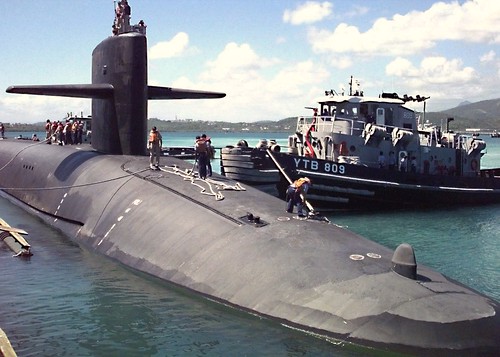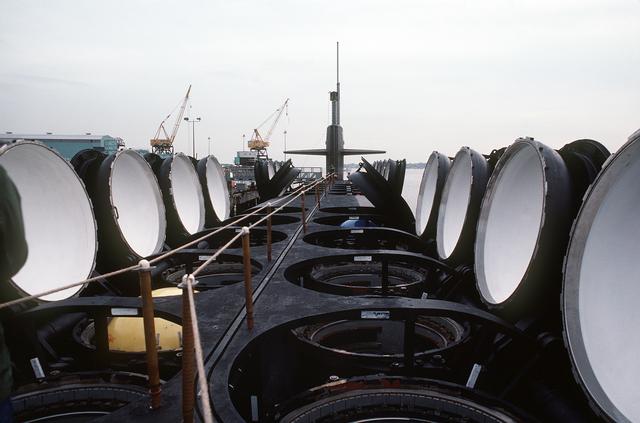Leeham News and Analysis
There's more to real news than a news release.
Trident subs pass milestone
I’m going to deviate from the usual editorial “we” and the usual Airbus and Boeing focus to share with readers my trip last week on a Trident nuclear submarine, referenced in this previous post.
Through my association as a columnist for Armed Forces Journal magazine, I was privileged to receive an invitation for a two day, two night embark on an SSBN sub in connection with the Navy’s recognition of the milestone 1,000th mission of the D-5 Trident missile.
The D-5 Trident missile serves as the submarine force’s principal nuclear deterrent. The SSBNs are one of three triads that protect this country against our adversaries. The land-based ICBM and the USAF represent the other legs of the triad, but the SSBNs today represent 54% of the deterrent force.
The SSBN consists of the Ohio class submarine, which is more than 18,000 tons when submerged. It carries 24 D-5 missiles with multiple, independent re-entry warheads. There were originally 18 Ohio-class subs built; four have been converted to guided missile SSGNs, each carrying approximately 150 Tomahawk missiles and up to 66 special operations forces when embarked. Here is the story I wrote about this conversion program. The Ohio, a Bangor-based sub, was the first SSBN to be converted to SSGN. This story was put together with the cooperation of Lt. Kyle Raines, the public affairs officer at Bangor, and Capt. Chris Ratliff, the first skipper of Ohio’s first SSGN mission.
The trip last week was my second embark. My first was in 2000 aboard the USS Alabama (SSBN-731) from Bangor, on Hood Canal. This was a short, three hour embark, arranged through a friend who is a retired Rear Admiral.
Eight journalists were invited to embark on the USS Maryland (SSBN 738). Our mission, which we all enthusiastically accepted, was to learn about the SSBN service and the relevance of the deterrence mission. I’ll be writing about the strategic aspects of Trident subs for Armed Forces Journal’s May edition.

USS Maryland. Source: Flickr.
The 1,000th D-5 mission was performed by the USS Wyoming (SSBN 742), a Kings Bay, GA,-based SSBN.

SSBN with missile hatches open. Source: eqneedf.spaces.live.com
Although anti-nuclear activists maintain that nuclear weapons, including the Tridents, bring the world closer to war, submariners believe the opposite: that the nuclear deterrent has prevented another global war.
In an interview with Cmd. Jeffrey Grimes, skipper of the Maryland, he acknowledged that the world has seen plenty of regional wars but that the Trident–and the Polaris subs that preceded the Ohios, as well as the other two legs of the Triad–served to prevent global hostilities. Grimes, as did the skipper of the Alabama on my embark nine years ago, and the crew all said that if the day ever comes when a D-5 is fired, the mission of deterrence failed.
The 1,000th mission milestone of the D-5s is a testament to the quality, technology and maintenance of the submarines and the crews that man them, Grimes told me. The subs routinely go on 60-90 day missions, limited only by the amount of food that’s on board. The subs are actually stocked for longer missions and, if necessary, can be rationed. (More about the food later.) After a short period in port, the subs turn around for another mission.
This is made possible by the use of Blue and Gold crews, which rotate with each mission. This enables the subs to be on patrol far more often than would otherwise be possible, and which enabled the subs to rack up the 1,000th mission in what is considered a short period of time (using 18 subs or fewer, accounting for the SSGN conversions) since the first deployment of the USS Ohio in 1982.
When I went on my three hour embark in 2000 aboard the Alabama, I was impressed then with the dedication and quality of the crew. This was reinforced with the two day embark on the Maryland.
Each branch of the military service is understandably proud of its members. Since I’ve not served in the military and have not embarked with other branches of the service, my experience with the Army, Air Force and Marines is limited to knowing individuals who have served in these branches. So while some may say my conclusions therefore are biased, I can only express nothing but pride and admiration in the submariners and the work they do.
It’s long been known that the submarine force has the best food in the Armed Services. I can certainly testify that the Maryland crew has a great menu and lots of food, and this is undoubtedly typical of the other subs. The pride of the cooks, who prepare four meals a day (the three regular mealtimes plus one for the overnight watch) in galley-kitchen that works 20 hours a day is obvious. There are no K-rations or MREs for these sailors.
The entire crew could not have been more hospitable to a bunch of nosy journalists. Naturally there were questions they could not answer and places on board we could not go. But they performed battle stations-torpedo and battle stations missile drills for us, demonstrating what’s involved and the security checks that prevent the scenario depicted in the popular movie, Crimson Tide in which the skipper (played by Gene Hackman) nearly launched nuclear missiles without proper authorization. Crimson Tide was set on board the Alabama; our embark on this sub was not too long after the movie came out, and that boat’s skipper was quick to tell us the movie’s scenario could not happen. Even so, the Maryland’s “Weps” (weapons officer, who actually fires the missiles) told us that procedures had been changed after the movie to further tighten security over the missiles.
The officers and crew of the Maryland, as I said, were gracious. From my own perspective, because of an unusual circumstance that arose as I embarked, it was necessary to communicate with my wife while I was at sea. The skipper, Cmd. Grimes, and executive officer (XO), LCmd Louis Springer and a couple of the chiefs, as well as public affairs officers on board and ashore, couldn’t have been more helpful.
I’d also like to mention the chiefs on board. It’s common knowledge that in the Army the sergeants “run” things. On the subs, so do the chiefs, overseeing their respective divisions and departments. The captain sets the policies and ultimately makes the decisions (and has the responsibilities). The XO implements the policies. And the chiefs make sure things work.
The Chief of the Boat, or COB, is the top chief’s slot and it’s a very prestigious position. The COB on the Maryland’s Gold crew, with whom we sailed, is Michael McLauchlan. He was, as with everything else, essentially in charge of us journalists. As with the skipper and XO, he couldn’t have been more gracious.
Every crew thinks their ship is special. In Maryland’s case, so does the Navy. In January, the Navy gave the Maryland the E for Excellence award, a highly coveted recognition, that in this case is a tribute to the Blue and Gold crews that man her.
Civilian embarks on submarines is exceedingly rare and one that I’m told has to ultimately be approved by the Navy Department in the Pentagon. I was privileged to embark nine years ago on the Alabama. Getting a second chance, and spending two days on board with some of America’s finest, is something I’ll never forget.
Here are several stories about the 1,000th mission.
From: Armed Forces News Services.
From: Jacksonville.com.
From: Seattle Post-Intelligencer.
From: the Kings Bay Periscope.
Here’s some information about the Kings Bay, GA, Trident Naval Training Base.
Puget Sound’s SSBN naval base at Bangor, WA, has its 1,000th Mission ceremony Thursday, Feb. 26. Kings Bay held its ceremony Feb. 19.


I was a Radioman rider on this patrol from the USS Tennessee. I believe that you got underway with the best boat and crew in the Navy, I hope to be slated in with the Gold Crews future patrols!
Thank you,
-ET3/SS Maier
Thankyou.
Remember Neville Chamberlain, British PM, who appeased Hitler – thus worsening the effort to defend Britain against Nationalsozialistische.
He ignored Winston Churchill’s warning.
(Churchill was not worried initially but changed his mind as the nature of Nationalsozialistische Germany became clearer. Churchill of course succeeded Chamberlain as PM and fought a war properly, hard and to unconditional surrender, as the US did against Imperial Shinto.
John David Lewis chronicles both efforts in his book Nothing Less Than Victoria – malevolent societies were led into peaceful productivity.
One little known fact was that the US military occupiers ghost-wrote a new constitution for Japan when its legislature was foundering in that task. The constitution separated church and state – people were free to worship Shinto but not to mix any religion with government.
Yet some commenters in recent Leeham News threads sneer at the constitution of the USA, from their cushy homes that wouldn’t exist if evil regimes had their way..